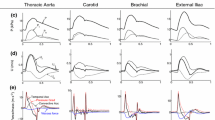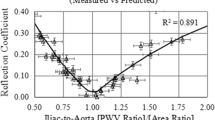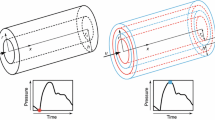Abstract
The effects of wave propagation phenomena, namely global reflection coefficient (ΓG[ω]) and pulse wave velocity (c ph), are studied in a model of the coupled left ventricle/arterial system. The left ventricle consists of a time-varying elastance, while the arterial system is modeled as a single, uniform, elastic tube terminating in a complex load. Manipulation of model parameters allowed for the precise control of (ΓG[ω]) andc phindependent of each other, peripheral resistance, and characteristic impedance. Reduction of ΓG(ω) andc ph were achieved through increases in load compliance and tube compliance, respectively. The equations describing the system were solved for left ventricular and aortic pressures and aortic flow. From these, stroke volume (SV), left ventricular stroke work (SW), and steady\((\dot W_s )\), oscillatory\((\dot W_o )\), and total power dissipation\((\dot W_t )\) in the arterial system were calculated. An index of arterial system efficiency was the ratio\(\dot W_o /\dot W_t (\% \dot W_o )\), with lower values indicating higher efficiency. Reduction of ΓG(ω) yielded initial increases in\(\dot W_s \), while\(\dot W_o \) increased for the entire range of ΓG(ω), resulting in increased\(\% \dot W_o \). This reduced efficiency is imposed on the ventricle, resulting in increasedSW without increasedSV. On the other hand, decreasedc ph yielded in a steady increase in\(\dot W_s \) and a biphasic response in\(\dot W_o \), resulting in reduced\(\% \dot W_o \) for most of the range of reducedc ph. These results suggest that differential effects on arterial system efficiency can result from reductions of ΓG(ω) andc ph. In terms of compliance, changes in arterial compliance can have different effects on efficiency, depending on where the compliance change takes place. Reasons for these results are suggested, and the role of distributed compliances is raised as a new problem.
Similar content being viewed by others
References
Berger, D. S., J. K-J. Li, and A. Noordergraaf. Differential effects of wave reflections and peripheral resistance on aortic blood pressure: a model based study.Am. J. Physiol. 266 (Heart Circ. Physiol. 35):H1626-H1642, 1994.
Berger, D. S., J. K-J. Li, W. K. Laskey, and A. Noordergraaf. Repeated reflection of waves in the systemic arterial system.Am. J. Physiol. 264 (Heart Circ. Physiol. 33): H269-H281, 1993.
Burattini, R., and K. B. Campbell. Effective distributed compliance of the canine descending aorta estimated by modified T-tube model.Am. J. Physiol. 264 (Heart Circ. Physiol. 33):H1977-H1987, 1993.
Campbell, K. B., L. C. Lee, H. F. Frasch, and A. Noordergraaf. Pulse reflection sites and effective length of the arterial system.Am. J. Physiol. 256 (Heart Circ. Physiol. 25):H1684-H1689, 1989.
Cholley, B. P., S. G. Shroff, J. Sandelski, C. Korcarz, B. A. Balasia, S. Jain, D. S. Berger, M. B. Murphy, R. H. Marcus, and R. M. Lang. Differential effects of chronic oral antihypertensive therapies on systemic arterial circulation and ventricular energetics in African American patients.Circulation 91:1052–1062, 1995.
Cox, R. H. Determination of systemic hydraulic power in unanesthetized dogs.Am. J. Physiol. 226:579–587, 1974.
Gibbs, C. L. Cardiac energetics.Physiol. Rev. 58:175–254, 1978.
Kelly, R. P., R. Tunin, and D. A. Kass. Effect of reduced aortic compliance on cardiac efficiency and contractile function ofin situ canine left ventricle.Circ. Res. 71:490–502, 1992.
Laskey, W. K., H. G. Parker, V. A. Ferrari, W. G. Kussmaul, and A. Noordergraaf. Estimation of total arterial compliance in man.J. Appl. Physiol. 69:112–119, 1990.
Merillon, J. P., G. J. Fontenier, J. F. Lerallut, M. Y. Jaffrin, G. A. Motte, C. P. Genain, and R. R. Gourgon. Aortic input impedance in normal man and arterial hypertension: its modification during changes in aortic pressure.Cardiovasc. Res. 16:646–656, 1982.
Milnor, W. R. Cardiac Dynamics. In:Hemodynamics. Baltimore: Williams & Wilkins, pp. 260–293, 1989.
Milnor, W. R., C. R. Conti, K. B. Lewis, and M. F. O'Rourke. Pulmonary arterial pulse wave velocity and impedance in man.Circ. Res. 25:637–649, 1969.
Milnor, W. R., D. H. Bergel, and J. D. Bargainer. Hydraulic power associated with pulmonary blood flow and its relation to heart rate.Circ. Res. 19:467–480, 1966.
Nichols, W. W., C. R. Conti, W. E. Walker, and W. R. Milnor. Input impedance of the systemic circulation in man.Circ. Res. 40:451–458, 1977.
O'Rourke, M. F. Steady and pulsatile energy losses in the systemic circulation under normal conditions and in simulated arterial disease.Cardiovasc. Res. 1:313–326, 1967.
Randall, O. S., G. C. Van den Bos, and N. Westerhof. Systemic compliance: does it play a role in the genesis of essential hypertension?Cardiovasc. Res. 18:455–462, 1984.
Shroff, S. G., D. S. Berger, R. M. Lang, R. H. Marcus, C. Korarcz, and D. E. Miller. Physiological relevance of T-tube model parameters: emphasis on arterial system compliance.Am. J. Physiol. 269 (Heart Circ. Physiol. 38): H365-H374, 1995.
Ting, C. T., K. P. Brin, S. J. Lin, S. P. Wang, M. S. Chang, B. N. Chiang, and F. C. P. Yin. Arterial hemodynamics in human hypertension.J. Clin. Invest. 78:1462–1471, 1986.
Urschel, C. W., J. W. Covell, E. H. Sonnenblick, J. Ross, Jr., and E. Braunwald. Effects of decreased aortic compliance on performance of the left ventricle.Am. J. Physiol. 214:298–304, 1968.
Westerhof, N., P. Sipkema, G. C. Van den Bos, and G. Elzinga. Forward and backward waves in the arterial system.Cardiovasc. Res. 6:648–656, 1972.
Author information
Authors and Affiliations
Rights and permissions
About this article
Cite this article
Berger, D.S., Li, J.KJ. & Noordergraaf, A. Arterial wave propagation phenomena, ventricular work, and power dissipation. Ann Biomed Eng 23, 804–811 (1995). https://doi.org/10.1007/BF02584479
Received:
Revised:
Accepted:
Issue Date:
DOI: https://doi.org/10.1007/BF02584479




